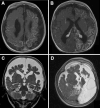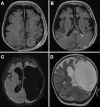Hemispherotomy for drug-resistant epilepsy in bilateral Sturge-Weber syndrome: illustrative cases
- PMID: 40759056
- PMCID: PMC12320728
- DOI: 10.3171/CASE25125
Hemispherotomy for drug-resistant epilepsy in bilateral Sturge-Weber syndrome: illustrative cases
Abstract
Background: Sturge-Weber syndrome (SWS) is a congenital neurocutaneous disorder characterized by angiomas of the face, choroid, and leptomeninges. Seizures in these children often present within the first 2 years of life. SWS is typically unilateral, but bilateral SWS occurs in approximately 15% of cases. Bilateral SWS is associated with earlier seizure onset and poorer cognitive, developmental, and functional outcomes. More than half of children with SWS develop drug-resistant epilepsy requiring surgical intervention. Hemispherotomy has been established as a successful treatment for unilateral SWS, but resective surgery has traditionally not been considered a treatment option for patients with bilateral disease.
Observations: In this report, the authors present the cases of 4 children (7 months-2 years of age) with bilateral SWS and drug-resistant epilepsy with a unilateral electroencephalography predominance. After a multidisciplinary conference in each case, all children were successfully treated with unilateral hemispherotomy. These patients achieved prolonged periods of seizure freedom postoperatively, a better quality of life, and demonstrated improved developmental progress at long-term follow-up.
Lessons: This case series suggests that functional hemispherotomy may be a safe and effective therapeutic option for improving seizure burden in cases of bilateral drug-resistant SWS with asymmetric seizure burden. https://thejns.org/doi/10.3171/CASE25125.
Keywords: Sturge-Weber; drug-resistant epilepsy; epilepsy surgery; hemispherotomy; pediatric.
Figures


Similar articles
-
Epilepsy surgery in Sturge-Weber syndrome with unilateral or bilateral asymmetric brain involvement: Boston Children's Hospital experience.Epilepsia. 2025 Jul;66(7):2198-2212. doi: 10.1111/epi.18387. Epub 2025 Mar 24. Epilepsia. 2025. PMID: 40126015
-
Sturge Weber syndrome in a multinational pediatric cohort: a systematic analysis of different types.Orphanet J Rare Dis. 2025 Jul 2;20(1):336. doi: 10.1186/s13023-025-03769-2. Orphanet J Rare Dis. 2025. PMID: 40604834 Free PMC article.
-
Idiopathic (Genetic) Generalized Epilepsy.2024 Feb 12. In: StatPearls [Internet]. Treasure Island (FL): StatPearls Publishing; 2025 Jan–. 2024 Feb 12. In: StatPearls [Internet]. Treasure Island (FL): StatPearls Publishing; 2025 Jan–. PMID: 31536218 Free Books & Documents.
-
Levetiracetam add-on for drug-resistant focal epilepsy: an updated Cochrane Review.Cochrane Database Syst Rev. 2012 Sep 12;2012(9):CD001901. doi: 10.1002/14651858.CD001901.pub2. Cochrane Database Syst Rev. 2012. PMID: 22972056 Free PMC article.
-
The Black Book of Psychotropic Dosing and Monitoring.Psychopharmacol Bull. 2024 Jul 8;54(3):8-59. Psychopharmacol Bull. 2024. PMID: 38993656 Free PMC article. Review.
References
-
- Comi AM.. Update on Sturge-Weber syndrome: diagnosis, treatment, quantitative measures, and controversies. Lymphat Res Biol. 2007;5(4):257-264. - PubMed
-
- Thomas-Sohl KA Vaslow DF Maria BL.. Sturge-Weber syndrome: a review. Pediatr Neurol. 2004;30(5):303-310. - PubMed
-
- Bebin EM Gomez MR.. Prognosis in Sturge-Weber disease: comparison of unihemispheric and bihemispheric involvement. J Child Neurol. 1988;3(3):181-184. - PubMed
-
- Bourgeois M, Crimmins DW, de Oliveira RS.Surgical treatment of epilepsy in Sturge-Weber syndrome in children. J Neurosurg. 2007;106(1)(suppl):20-28. - PubMed
LinkOut - more resources
Full Text Sources

